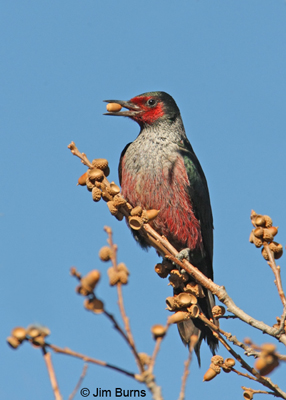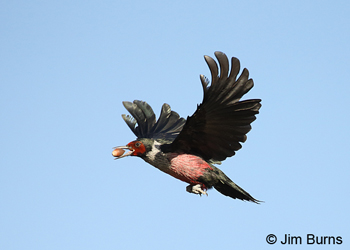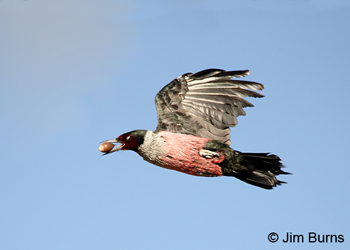
I gravitated from birding with binoculars to birding with camera a couple decades ago when I realized that observing how birds live their lives was more challenging and more rewarding to me than simply seeing them and running up a score on a checklist. The camera dictates that I move more slowly and cover less ground, but more importantly it’s an excuse to linger and witness behavior, which I call “lifestyle.” It’s calming, fascinating, and invariably leads to more questions than answers.
The initial report from a week or ten days ago said the bird was seen in a Fan Palm near the volleyball courts. Right, and I’m often seen in my front yard . . . except when I’m not. I’ve parked right in front of the volleyball courts, and as I exit the vehicle I glance at the row of palms behind them. There’s a Lewis’s Woodpecker siIhouetted on the first one, about 25 feet up, plainly visible under the bottom of the untrimmed fronds. I still have one foot inside the car and I’m still reaching for binoculars and camera.
There was a time, years ago, when I might have just swung right back into the driver’s seat and headed home, mission accomplished. Site fidelity, sometimes even down to a specific tree, for overwintering birds has always amazed me, probably because I’ve so often in my birding lifetime been in the right place at the wrong time. Really, this woodpecker this morning could be a hundred miles from here, or it could be in a tree a hundred yards away hunkered down so I would never find it in a day long search.
I walk over to a picnic table and sit down in a sunshaft to ameliorate the early morning chill. Lewis’s Woodpecker is generally listed from “uncommon and rare” (Arizona) to “fairly common but local” (throughout the interior West). I saw it in Washington and Colorado before I saw it here in Arizona, and my first in state sighting actually happened as I was running the Prescott marathon one November. If I had to see one on breeding territory, I’d go to the White Mountains in summer and search open Ponderosa Pine or pine/oak forest.
Oaks and their acorns are certainly the habitat markers for Lewis’s during their winter altitudinal migrations and occasional lowland irruptions. I remember once counting ten(!) hanging out together, storing acorns, in pine/oak one November on top of Mt. Ord. Palm trees, though, not so much. Lewis’s Woodpecker in a palm tree is not mentioned in The Twelve Days of Christmas and must surely be one of the ultimate birding oxymorons. Nonetheless, I do have a personal record of a Lewis’s in the Parker Oasis along the Colorado River on a February, 1990 field trip, and I know there are palms along the lower Colorado.
I watch as the Lewis’s drops from the palm, literally, then levels out ten feet off the ground, and flies off to the northwest. I am sure he will return. There is no rational reason to assume this bird is a male because Lewis’s must be examined in hand to determine sex, but I have so labeled him because the species was named for Meriwether Lewis, its first descriptor, and Lewis is a male name. I am certain he will return to this palm because he has apparently been here in the same place ten days, and every day I sit in the same chair to read the morning newspaper. So, I am twice guilty, once for anthropomorphizing and once for concocting an egregious non-sequitur.
He returns. I stand up and take one picture for the record, then start to sit down when it dawns on me what the camera just captured him doing—caching an acorn. The wheels are turning, and now I’m all in. As he leaves again I move quickly toward the palm so I can see where he goes. Not far. Thirty yards away is a small oak. “Lewis” (see how my mind rolls) disappears into the thickest branches, roots around for a moment, then flies out with another acorn, returns to the same place, and adds to his cache at the base of a trimmed palm frond.
I shoot for three hours, mostly Lewis in flight, because I’ve never had a chance for flight shots of a Lewis’s Woodpecker, and how often can I expect to nail the focus? About halfway through the session Lewis begins utilizing a different but nearby oak and a new cache farther away in a condo complex across a busy surface street. The new cache is also at the base of trimmed fronds in a tall palm. As the morning warms, his trips become a continuous stream of comings and goings, gleanings and cachings, but when noon hour approaches things slow down, and ultimately he flies out of sight to the south, gone for the day.
Back home on the computer I peruse the morning’s images, well over 100. Disappointment with how many are trash is softened by the satisfaction of a few keepers. All you need is one good one, right? I am delighted to have gotten an intimate look at a slice of Lewis’s Woodpecker life that many birders will never see. Then, as I progress through my work flow from checking focus to looking for compositions that might reveal aspects of that lifestyle, I am blown away by a sudden realization. Two patterns emerge that I had not noticed through the viewfinder in the camera--that could not have been noticed in the fractions of moments when Lewis was actually seen in flight through the viewfinder.
To wit, in every frame over dozens of flights the acorn is carried in exactly the same way, not perpendicular to the bill but parallel to it with the larger, heavier end outward and, in many of the frames the nictitating membrane is deployed across the eye. More questions than answers! There must be a reason a bird always carries a food item in the same precise way? And who knew that birds, some birds anyway, fly with the nictitating membrane closed? Can they even see with it closed?
As I ponder the first question, I remember that Osprey always carry fish the same way, parallel to their body and head first. It is assumed that this is evolutionary behavior learned by this species for aerodynamic flight. Birds are, for their very survival, all about energy conservation. How inefficient would it be to fly with the tail of the fish forward catching the wind and flapping side to side. An acorn, though, is rigid and its bottom end, the style, is thinner than the stem end.
Here is what I decide about Lewis and his acorns. Yes, parallel to the bill for aerodynamic flight, and it is easier to wedge the style end into the bill because that is the more tapered end, but additionally and perhaps more importantly, for ease of storage. To my knowledge woodpecker species eat at their cache rather than removing the food and taking it elsewhere to consume. If the acorn were placed style down into the crevice, it would be off balance and might fall out. And at mealtime the acorn would shift around under the force of pecking it to expose the protein inside. To preclude this, to infill around the stored style, would require time and energy.
Think mortar and pestle, the crevice becomes the mortar, the woodpecker bill is the pestle. We’ve observed Gilas, Gilded Flickers, and Curve-billed Thrashers dig shallow depressions in the dirt of our yard, then roll ripe Russian Olives into them before jabbing with their bill to open the fruit. This is, in a way, tool usage, the crevice or the depression, in fact, tools.
Having established that Lewis is smart enough to gather and cache most efficiently, here’s what I gleaned from the literature about his nictitating membrane after reviewing his photos. Its purpose is to clear debris and moisturize the eye, and in flight would be one of the most critical times to utilize it. In some species it is transparent, in some opaque, so drawing it across the eye does not completely cut off a bird’s vision. Though I had never seen or taken a flight photograph showing the nictitating membrane, most birds apparently do close it briefly, but repeatedly, in flight.
There remains only one unanswered question. My new sunglasses are “transitions,” and the first time I wore them was the morning in the park with Lewis. I noticed as I moved to keep the sun behind me and the camera between the Lewis and the sun, the lens on the sunny side, as advertised, definitely “transitioned” darker. Can birds do this? I caught Lewis both coming and going with the sun always in the eastern sky, so I have no photos showing both sides of his head. I infer from my reading that shielding the eye from ultraviolet rays is one purpose of the nictitating membrane. Do birds’ “third eyelids” work in conjunction with one another, or can they be used independently, sunny side only?
Lewis’s Woodpecker, Melanerpes lewis, with its bottle green back, silver collar, red face, and salmon underparts, is a uniquely beautiful bird, the favorite in its family for many birders. It is also unique among the woodpeckers because of its “lifestyle”—it flies like a crow, captures insects on the wing, and at times migrates in flocks. Without the camera, Lewis would be just a checkmark on a list. With the camera, my morning with him becomes a memorable avian seminar.
